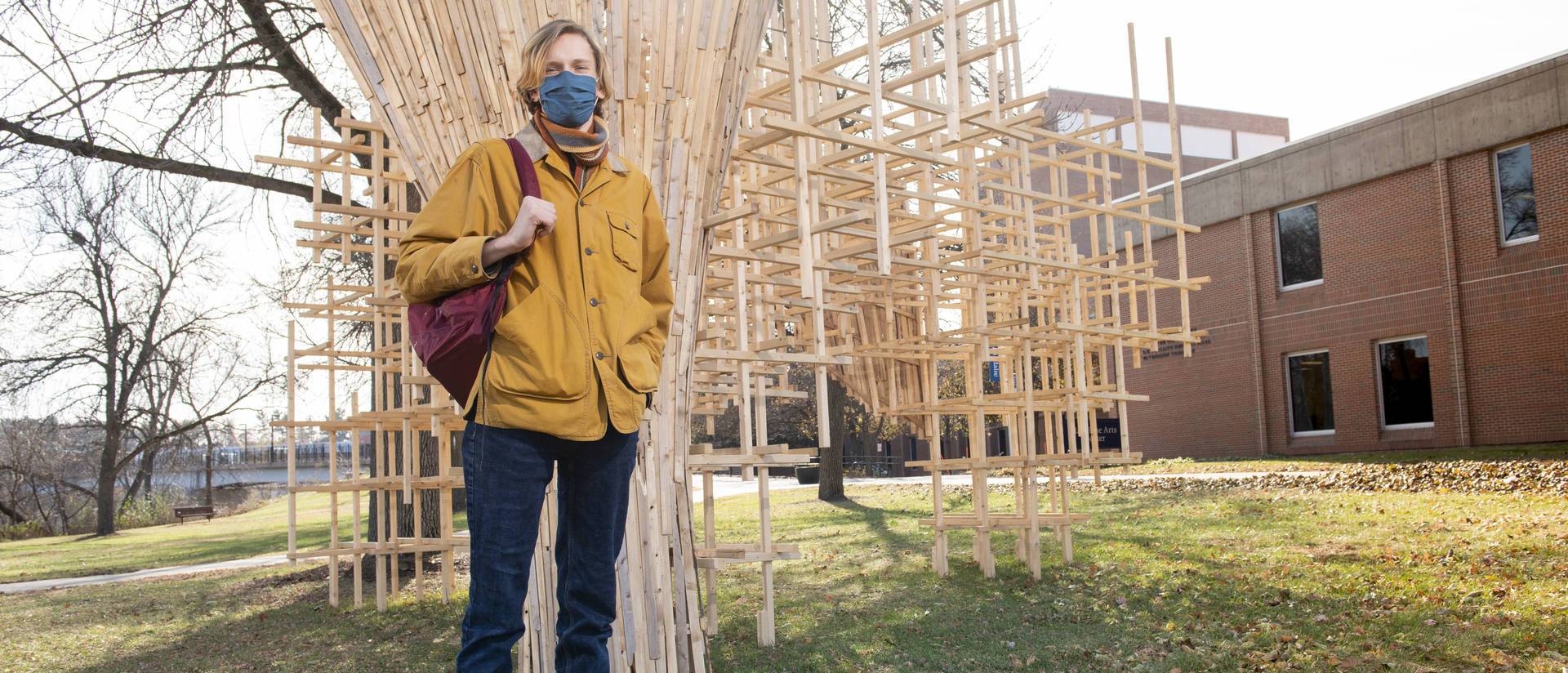
UW-Eau Claire senior Caleb Carr is passionate about art and feels a social responsibility to speak up about sustainability and the future of our planet.
Caleb Carr grew up on a southwest Wisconsin farm and, from a young age, understood the importance of natural resources and the environment in his family’s rural lifestyle.
The University of Wisconsin-Eau Claire senior from Hollandale says his country upbringing helped instill in him a belief that people need to respond to the Earth’s climate crisis and make sustainability a part of their everyday lives before it’s too late.
“The future does not look bright without changes,” Carr says. “It’s easy to give up. But there is a fight to be had and changes to be made. We’ve got to be the ones to make them.”
Carr, an art major with an emphasis in illustration, isn’t afraid to jump into that fight and is conveying that sustainability message through an exhibition he proposed and curated at the Ruth Foster Art Gallery in the Haas Fine Arts Center.
“The Nature of Our Disposition,” open through Nov. 11, is the first outside exhibition — an exhibit of professional artists from outside the community — known to be curated by a UW-Eau Claire student in the 50-year history of the Foster Gallery, established in 1970 when the Haas Fine Arts Center opened.
This semester, the Foster Gallery is open only to UW-Eau Claire students, faculty and staff because of COVID-19.
“I feel so satisfied and so proud of the work that was done,” Carr says. “I feel particularly proud of being able to investigate and find the intersection between sustainability and art.
“I’m passionate about art but I feel sustainability is more of a social responsibility. It’s a way of being responsible and coping with the anxiety of an uncertain and unsafe future.”
Carr, who has been involved with sustainability initiatives through the UW-Eau Claire Student Office of Sustainability, worked as a Foster Gallery attendant and often wondered how gallery officials chose the artwork that is on display. Amanda Bulger, interim director of the Foster Gallery, explained to him that a committee looks at proposals and considers a variety of factors that include the exhibition’s uniqueness, impact and connection to the university and community.
Bulger worked with Carr on his proposal to combine sustainability and art to ensure it illustrated his goals and direction for the exhibition.
“The Foster Gallery committee was excited about his proposal and endorsed it but was concerned the workload could be overwhelming for a student,” Bulger says.
At Bulger’s suggestion, Carr sought out mentors Ned Gannon, professor of art & design, and Dr. David Tschida, associate professor of communication and journalism, for guidance on the project. The mentors advised Carr on startup aspects of the exhibition such as theme, title, promotion, budgeting and other tasks.
Carr took care of most of the exhibition tasks, including contacting the artists and finding creative ways to make the exhibit more sustainable. For example, Carr created handmade seed paper from recycled gallery materials to create signs to introduce the exhibit and its artists on the east end of the gallery. Rather than mounting some photos on aluminum sheets, he used a technique to hang them with screws and magnets that could be reused in future exhibits.
“Caleb excelled throughout the entire process,” Bulger says. “He was professional, excited and creative in all aspects of planning, communicating, designing and installing the exhibition.”
COVID-19 presented many challenges to the exhibition planning, but Carr worked through the in-person limitations to bring the exhibition to fruition.
“Personally, I never questioned that the exhibition could happen in one form or another, but I did not expect Caleb to so gracefully and creatively roll with punch after punch,” says Gannon, calling Carr an “eternal optimist.”
Carr considers himself an optimist out of necessity.
“I have to be optimistic or it’s so easy to slip into anxiety and dread,” Carr says matter-of-factly. “The climate crisis is basically about the world ending and humanity ending. It’s so easy to shut down out of self-preservation. It’s important to be optimistic and to be positive to deal with such a serious and heavy issue.”
Carr researched other exhibitions, looking at the approaches of other galleries and which artists were highlighted.
The exhibit has a variety of mediums — photography, sculpture, prints and video projections — and Carr found it challenging to select the right artists for the exhibition because “sustainability intersects with everything.”
Artists in the exhibition are from Wisconsin, Minnesota and the United Kingdom so there is a blend of regional, national and international works.
Carr found that curating an exhibit was a different perspective for an artist like himself who hadn’t ever thought about that aspect of the profession before.
“I really enjoyed doing the curatorial side of things,” Carr says. “Art can sometimes be kind of a lonely endeavor. You’re sitting at the canvas painting for hours and hours before you get to interact with anybody. I love being able to work with artists and the community and to connect artists with the community.”
Eventually he’d like to be an art educator, but sustainability remains at the forefront of his mind.
“Career goals seem so unimportant in this conversation of the future of the planet and the future of humanity,” Carr says. “There are solutions; we just have to be brave and address them head-on.”
